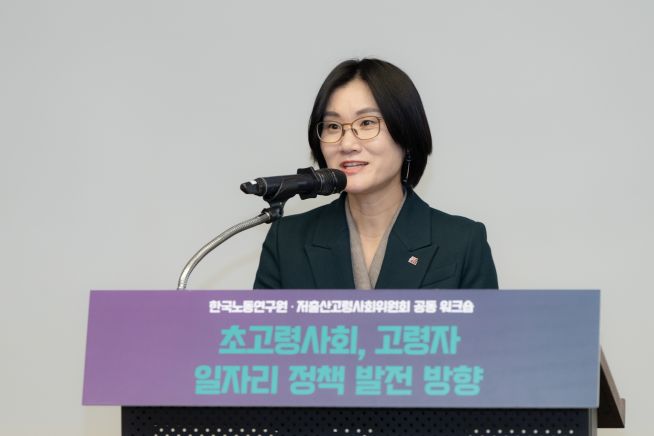The low birth rate and aging committee is beholden to a ‘borrowed sack of barley’, the shadow of ‘lack of capacity’ hidden behind budget problems
Population control tower ‘Yumyeong Musil’, ‘agent’ to solve low birth rate problem Committee on low birth rate and aging population raised ‘budget issue’: “It is difficult to design policies without budget authority” Some point out ‘lack of capacity’, “Failure to solve key challenges is the fundamental cause”

The Low Birth Rate and Aging Society Committee, which can be said to be the control tower of our country’s population policy, is on the chopping block. Even though a year has passed since President Yoon Seok-yeol ordered special measures to solve the ultra-low birth rate problem, no clear answer has been provided. The Low Birth Rate and Aging Committee, chaired by the President, gathered all the ministers of the major ministries below, but it was unable to play the role of presenting new policies or coordinating existing policies. It is pointed out that in order to come up with effective measures to bring about a rebound in the birth rate, the structure of the low birth rate and aging society, which is no different from a ‘vegetation’, must be overhauled.
Low Birth Rate and Aging Committee’s ‘Chopping Board’, “The problem of lack of policy function is serious”
In a survey of 17 population experts conducted on the 10th, 7 experts cited ‘lack of budget and policy functions’ as the biggest problem of the low birth rate and aging committee. The overwhelming majority of responses compared to ‘lack of professionalism among public officials’ (1 person) and ‘indifference of the president as chairman’ (1 person), pointing out that the lack of budget authority is leading to poor policies. The Low Birth Rate and Aging Committee, which was launched in 2005 as a government-wide consultative body to oversee population policy, was blameless in terms of its concept alone. The President is the chairman, the vice-chairman who leads the Low Birth Rate and Aging Committee is at the ministerial level, and the standing members are at the vice minister level. The two deputy prime ministers, including the Minister of Strategy and Finance, who oversees the budget, and the Minister of Education, who oversees education policy, both participate in the Low Birth Rate and Aging Committee. The Low Birth Rate and Aging Committee was where about 20 people, including the president, ministers, and private sector experts from various fields, worked together to design and coordinate population policies.
However, the control tower function of the low birth rate and aging society is currently ineffective. Accordingly, some point out that a small organization made up of dispatched civil servants cannot develop proper policies. Currently, only a small number of people (about 30 people) are working in the secretariat in charge of the low birth rate and aging committee, and even these people are dispatched from each ministry and return to their original ministry after about a year to a year and a half. In response to this, a civilian member of the Low Birth Rate and Aging Committee pointed out, “The current Low Birth Rate and Aging Committee is structured in such a way that it cannot develop expertise and a sense of mission on the low birth rate issue.” Some say that in order for the Low Birth Rate and Aging Committee to come up with effective policies, the president, who chairs the committee, must show more will and take action directly. President Yoon presided over the meeting of the Low Birth Rate and Aging Committee in March last year, but the meeting was held without the president for nearly a year thereafter. Lee Sang-rim, a researcher at the Korea Institute for Health and Social Affairs, raised his voice, saying, “Ultimately, it is the president who can coordinate differences of opinion between ministries and lead them to move in one direction.” He added, “Meetings in which the president participates need to be regularized.”
A control tower without authority, in effect a ‘plant’
It is not just President Yoon’s problem that has become a sack of barley made by the Low Birth Rate and Aging Committee. This is because during the Moon Jae-in administration, there was not a single meeting of the Low Birth Rate and Aging Committee held under the president’s chair. The steering committee, co-chaired by Kim Young-mi, vice chair of the Low Birth Rate and Aging Society Committee, has been held four times so far, but the other co-chair, Minister of Health and Welfare Cho Kyu-hong, has never attended the steering committee. This is proof that everyone already knows that the Low Birth and Aging Committee, which is only an advisory body, has inherent limitations in focusing its capabilities on managing the population crisis.
Experts point out that the Low Birth Rate and Aging Committee has no real authority, cannot directly execute the budget, and has little power to coordinate other ministries. Just looking at the recently announced budget for next year, the inherent limitations of the Low Birth Rate and Aging Society Committee are revealed. First, the Ministry of Strategy and Finance included 2024 trillion won in the budget related to ‘overcoming low birth rate’ in the 17 budget. Based on the projects included in the ‘Full-cycle support to reduce the burden of childbirth and childcare’ in the budget, the budget for this item was 5,900 trillion won this year, an increase of about 14%. Specifically, it includes measures such as expanding parental benefits, easing eligibility for low-interest loans for households with newborns, and establishing a special supply of apartments for households with newborns. However, the Low Birth Rate and Aging Committee did not provide a comprehensive explanation of these low birth rate measures. This means that each ministry is not integrated in its low birth rate policy, with the Ministry of Health and Welfare responsible for parental benefits and the Ministry of Land, Infrastructure and Transport responsible for special provision for newborns. Although the Low Birth Rate and Aging Society Committee consults with relevant ministries during the policy establishment process, there is criticism that measures are fragmented and difficult to come up with comprehensively.

Only superficial policies are ‘sprawling’, “measures against low birth rate are effectively ‘failure’”
There are also loud voices about budget shortages. Regarding this, a population expert said, “If we remove the bubble budget related to the low birth rate and aging population, the budget directly related to the low birth rate, such as parental leave, child care support, and child allowance, is only about 51 trillion won, or 38% of last year’s 19 trillion won budget. “It hits,” he explained. He also pointed out, “Korea’s low birth rate budget is about 5,000% of GDP, which is far below the OECD member country average of 1.56%.” The reason why the budget is not being executed properly is because the Low Birth and Aging Committee has no authority regarding the budget. Ideas from the Low Birth Rate and Aging Committee are delivered to each ministry and ministries’ opinions are collected, but that is all. A civilian member of the Low Birth Rate and Aging Committee, who requested anonymity, said, “I don’t know what the budget will be, but the Low Birth Rate and Aging Committee cannot come up with measures alone, and the ministries only say that it is ‘difficult’ because each ministry has other things that are more urgent.” He added, “Even groundbreaking measures can only come out if there is money.” He complained.
However, some argue that lack of expertise in manpower is a bigger problem than lack of budget. In fact, if you look closely at the existing low birth rate measures, the reality is that there are almost no fundamental policies to solve the low birth rate. In response to this, Lee Seong-yong, President of the Population Society of Korea, raised his voice, saying, “We have spent tens of trillions of won on low birth rate measures, but it is difficult to find anything that can actually solve the low birth rate.” He added, “There is a need to establish measures directly related to Korea’s reality.” Choi Seul-gi, a professor at the Korea Development Institute (KDI) Graduate School of International Policy, also commented, “We need to avoid department store-style measures and consider and select whether they are truly effective in resolving the low birth rate.”
According to the National Committee on Low Birth and Aging, a total budget of 2006 trillion won was invested to respond to low birth rate and aging over the 2020 years from 15 to 280. Although this is by no means a small amount, experts assess that the government’s low birth rate measures have effectively ‘failed.’ Even with the budget being invested, the total fertility rate continued to plummet, eventually falling to the lowest level in the OECD, and finally falling to 2022 in 0.78, less than half the OECD average. Experts said, “The rush to execute the budget in a situation where the establishment of an economic and social system to expand the economically active population is insufficient has led to blind spots in policy,” adding, “The key factors behind the low birth rate are employment instability, housing burden, burden of childbirth and childcare, “The government has failed to fundamentally resolve core challenges such as intensifying competition in education and difficulties in balancing work and life,” he said. In order to solve the low birth rate problem, it is necessary to once again bring out the ‘capacity’ issue of the Low Birth and Aging Committee itself, which is hidden behind the budget problem.






![[기자수첩] 논리적 사고 ① 성숙한 시민의식을 위해선 수학교육부터 바로 세워야](https://ipmkts.com/wp-content/uploads/sites/8/2023/11/인과추론-768x432.jpg)


 네이버계정으로 로그인하기
네이버계정으로 로그인하기
 카카오톡 계정으로 로그인하기
카카오톡 계정으로 로그인하기
